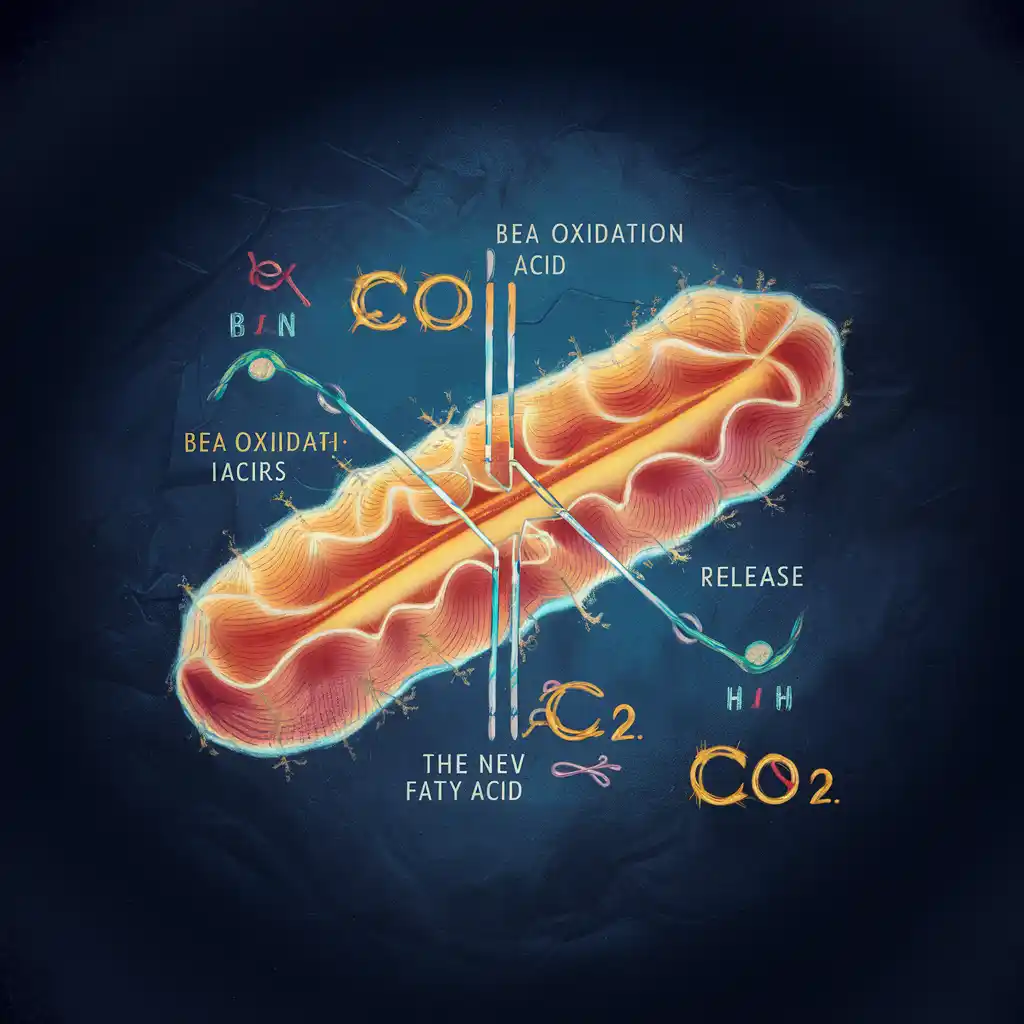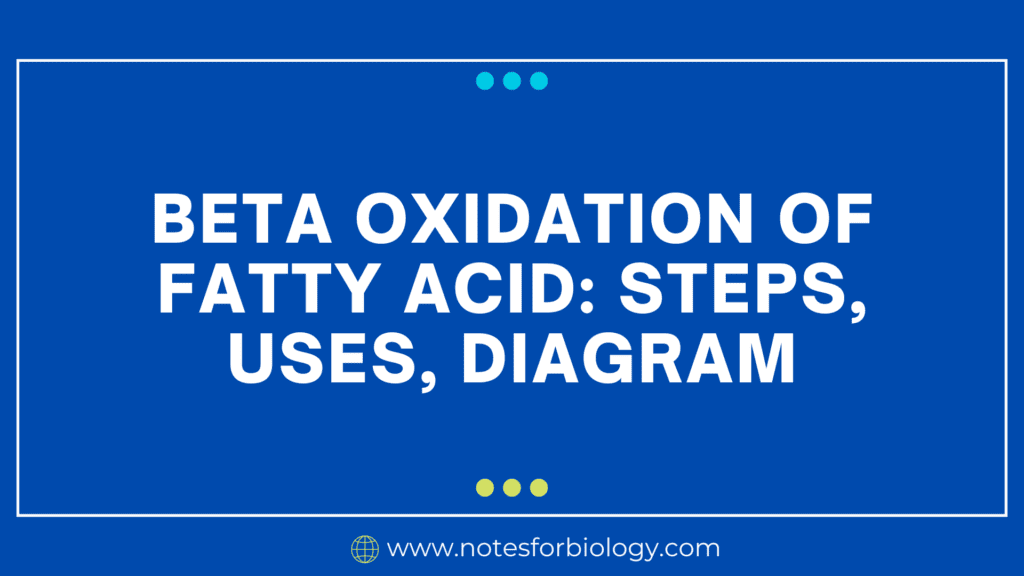Beta oxidation of Fatty Acid is a vital metabolic process which occurs in the mitochondria when fatty acids are broken down to create energy. Fatty acids are transformed into acetyl-CoA, which enters the citric acid cycle, and FADH and NADH₂, which are needed to produce ATP in the electron transport chain. The activation of the fatty acids, transport into the mitochondria, and a sequence of oxidation and cleavage processes are some of the stages that make up this route. In addition to being crucial for the production of energy, particularly during fasting or extended exercise, beta oxidation of fatty acid is also important for fat metabolism and weight control.
Table of Contents
Beta Oxidation of Fatty Acid

Beta oxidation of Fatty Acid is the process by which fatty acids are broken down in the mitochondria of cells to produce acetyl-CoA, which enters the citric acid cycle, and NADH and FADH₂, which are employed in the electron transport chain to produce ATP.
Steps of Beta Oxidation
In the mitochondria of cells, a multi-step process known as beta oxidation breaks down fatty acids to produce acetyl-CoA, NADH, and FADH₂. The steps of Beta oxidation of Fatty Acid are explained in full below:
- Activation of Fatty Acids:
- Location: Cytoplasm
- Enzyme: Acyl-CoA synthetase
- Method: To create fatty acyl-CoA, fatty acids are bonded to coenzyme A (CoA). This activates the fatty acids. As ATP is used up in this mechanism, it is transformed into AMP and pyrophosphate (PPi).
- Equation: Fatty acid + CoA + ATP → Fatty acyl-CoA + AMP + PPi
- Transport into Mitochondria:
- Enzyme: Carnitine acyltransferase I (on the outer mitochondrial membrane) and Carnitine acyltransferase II (on the inner mitochondrial membrane)
- Process: The inner mitochondrial membrane prevents fatty acyl-CoA from passing through it directly. The enzyme translocase then moves it into the mitochondrial matrix after carnitine acyltransferase I has first converted it to acyl-carnitine. It gets converted back to fatty acyl-CoA within by carnitine acyltransferase II.
- Equation: Fatty acyl-CoA + Carnitine → Acyl-carnitine + CoA (outside mitochondria)
Equation: Acyl-carnitine + CoA → Fatty acyl-CoA + Carnitine (inside mitochondria)
- Dehydrogenation (First Oxidation):
- Location: Mitochondrial matrix
- Enzyme: Acyl-CoA dehydrogenase
- Process: The fatty acyl-CoA undergoes dehydrogenation, forming a trans double bond between the α (C2) and β (C3) carbon atoms. This step produces FADH₂, which enters the electron transport chain.
- Equation: Fatty acyl-CoA + FAD → Trans-Δ²-enoyl-CoA + FADH₂
- Hydration:
- Enzyme: Enoyl-CoA hydratase
- Process: Water is added to the trans double bond of trans-Δ²-enoyl-CoA, converting it into L-3-hydroxyacyl-CoA.
- Equation: Trans-Δ²-enoyl-CoA + H₂O → L-3-hydroxyacyl-CoA
- Dehydrogenation (Second Oxidation):
- Enzyme: L-3-hydroxyacyl-CoA dehydrogenase
- Process: The hydroxyl group on the β carbon of L-3-hydroxyacyl-CoA is oxidized to a keto group, forming 3-ketoacyl-CoA. This step produces NADH, which also enters the electron transport chain.
- Equation: L-3-hydroxyacyl-CoA + NAD⁺ → 3-ketoacyl-CoA + NADH + H⁺
- Thiolysis:
- Enzyme: β-ketothiolase
- Process: The 3-ketoacyl-CoA is cleaved by the addition of a CoA molecule, producing acetyl-CoA and a fatty acyl-CoA shortened by two carbon atoms. This shortened fatty acyl-CoA re-enters the beta oxidation cycle.
- Equation: 3-ketoacyl-CoA + CoA → Acetyl-CoA + Fatty acyl-CoA (shortened by 2 carbons)
Uses:
The uses of Beta oxidation of Fatty Acid are given below:
- Energy Generation: Primary ATP Source: Provides ATP, particularly when a person is fasting or deficient in carbohydrates. When glucose levels are low, sustained energy provides constant energy.
- Managing Weight: Enhances the process of breaking down fat reserves for energy production. Weight loss and maintenance of a healthy metabolic rate are supported by metabolic rate.
- Preserving Blood Sugar Levels: Supports Gluconeogenesis: Supplies acetyl-CoA and energy needed for the production of glucose. Lessens the requirement for the energy-producing breakdown of protein.
- Cellular Health and Function: Enables effective synthesis of energy within the mitochondria. Reduces the buildup of triglycerides and fatty acids by regulation of lipid metabolism.
- Adaptation to Dietary Changes: Effectively breaks down dietary fats through metabolism. Adapts to various dietary patterns, such as ketogenic diets, thanks to metabolic flexibility.
- Exercise Performance: Helps postpone the onset of weariness during prolonged activities. Gives sustained energy during extended workout.
Summary: Beta oxidation of Fatty Acid is the metabolic process that breaks down fatty acids in the mitochondria. It takes place in multiple stages: fatty acids are activated to form fatty acyl-CoA, which is then transported into the mitochondria by the carnitine shuttle. Subsequently, acetyl-CoA, NADH, and FADH₂ are produced through a series of oxidation and cleavage processes. To create ATP, these products go through the electron transport chain and citric acid cycle. Beta oxidation of Fatty Acid helps control blood glucose levels, promotes weight management, assures effective cellular function, and facilitates lipid metabolism. It is particularly important for energy production during fasting or extended exercise.
Frequently Asked Question(FAQ)
What is beta-oxidation?
Beta-oxidation is a metabolic process which occurs in the mitochondria when fatty acids are broken down into acetyl-CoA molecules. NADH and FADH2, which are produced by this mechanism, are utilized by the electron transport chain to create ATP.
Where does beta-oxidation occur in the cell?
The mitochondria of cells are the primary sites of beta-oxidation. It can also happen in peroxisomes in specific organisms and situations.
Related Articles

